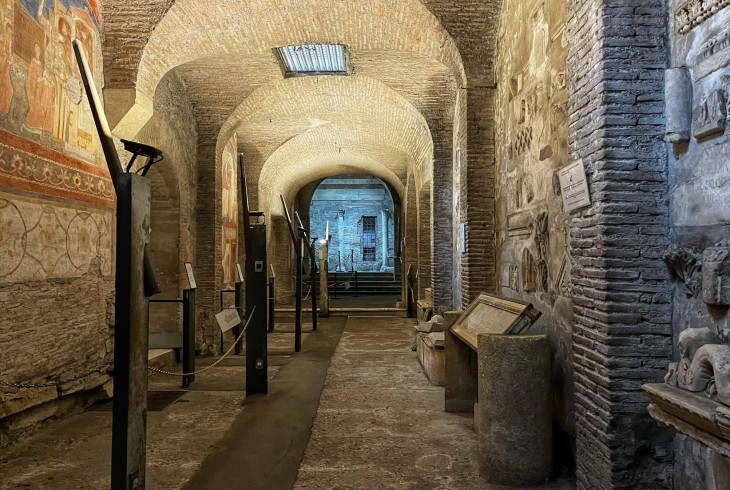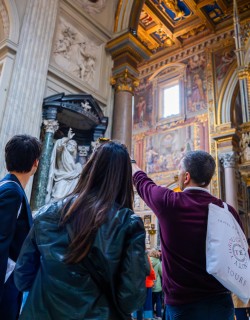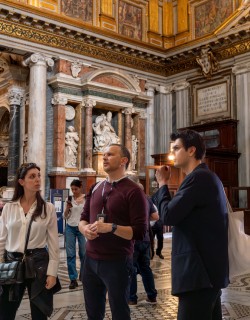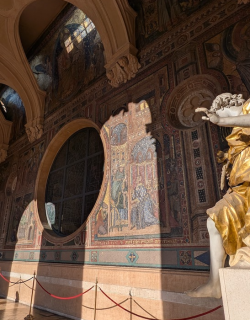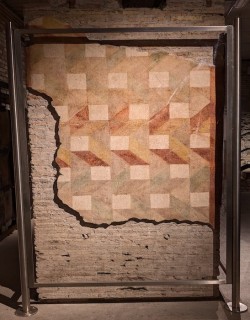If you take a short walk from the Colosseum along the narrow Via di San Giovanni, you will find a little square with some trees, a couple of marble benches and a few cafeterias. Unusually quiet for being so close to the most iconic building of the ancient Rome, this little peaceful square hides a real treasure: Saint Clement’s Basilica.
Built in the 12th century right on top of a more ancient church, Saint Clement’s Basilica is a wonderful example of Medieval architecture, art, spirituality and symbolism.
Most people, though, just pass by without even looking at this shabby building that hardly looks like a church from the outside. But for the lucky ones who take the time to enter, Saint Clement’s Basilica has many amazing surprises in store. Here we will just describe a few of them, only seven: Saint Clement’s Seven Wonders.
1. The ceiling
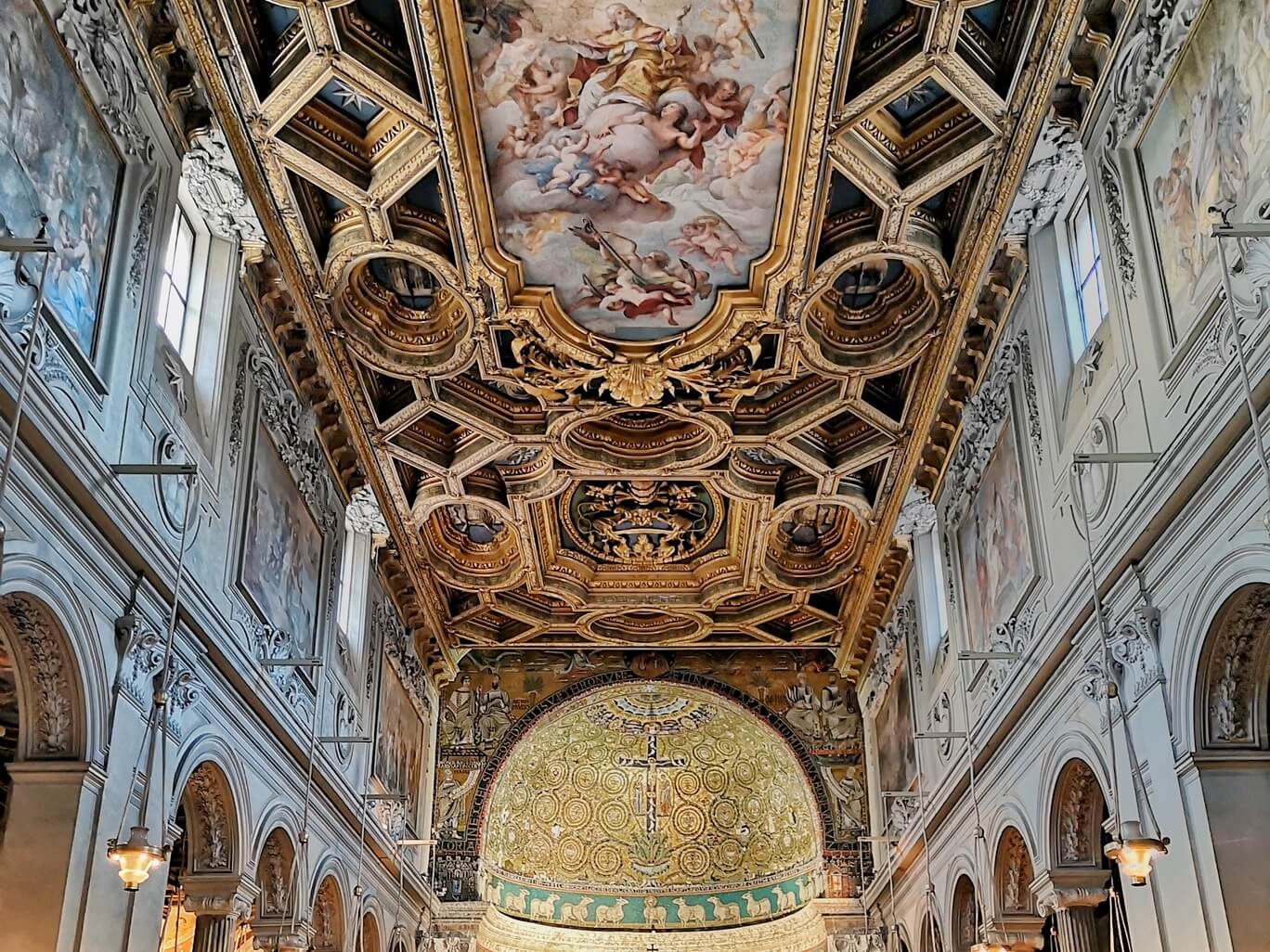
Designed at the very beginning of the 1700s by the architect Carlo Stefano Fontana, the ceiling of Saint Clement’s Basilica is one of the finest and richest in the city of Rome. Made entirely of wood and gold, the ceiling is decorated with a variety of geometrical patterns, stars, palm leaves and symbols related to the papacy, like the tiara or Saint Peter’s keys. In particular we can admire the beautiful carving with the coat of arms of Pope Clement XI (1700-1721), who sponsored many restoration works in this very Basilica.
In the middle of the ceiling we can appreciate a beautiful painting by Giuseppe Chiari (1654-1729): “The glory of Saint Clement”. This huge canvas displays the saint while being lifted up to Heaven by many angels, who also carry a big anchor.
What is the anchor for? And, first of all, who is Saint Clement?
Very little is known about the saint to whom this amazing church is dedicated, so there is unfortunately no certainty about his true identity. Some scholars believe that he is to be identified with Pope Clement, the fourth pope of the history, while others believe he was not a pope, but rather emperor Domitian’s cousin, who died as a martyr during the persecutions of the 1st century AD. During the Middle Ages, Saint Clement became the protagonist of a series of intricate legends: according to these imaginative tales, he was indeed a Pope and he died as a martyr, tied to an anchor and thrown into the Black Sea by order of emperor Trajan. So, still nowadays, the anchor is associated to Saint Clement, and that’s the reason why you see this symbol painted or carved everywhere in this beautiful church.
2. The mosaics and the floor

In Saint Clement’s Basilica, the mosaics play a key role in decorating the apse. When you first enter the church, you can’t help but be spellbound by the shimmering light reflected by thousands of golden tiles, creating unique light effects. The mosaics depict a variety of characters and symbols, such as the beautiful cross in the very center, each one hiding a deep mystical symbolism.
Surrounded by all this amazing art, one can easily forget to look at the floor, but the floor is just as fascinating as the rest. You will notice an amazing geometric pattern made of colourful varieties of marble, probably recycled from some other ancient buildings of the surroundings.
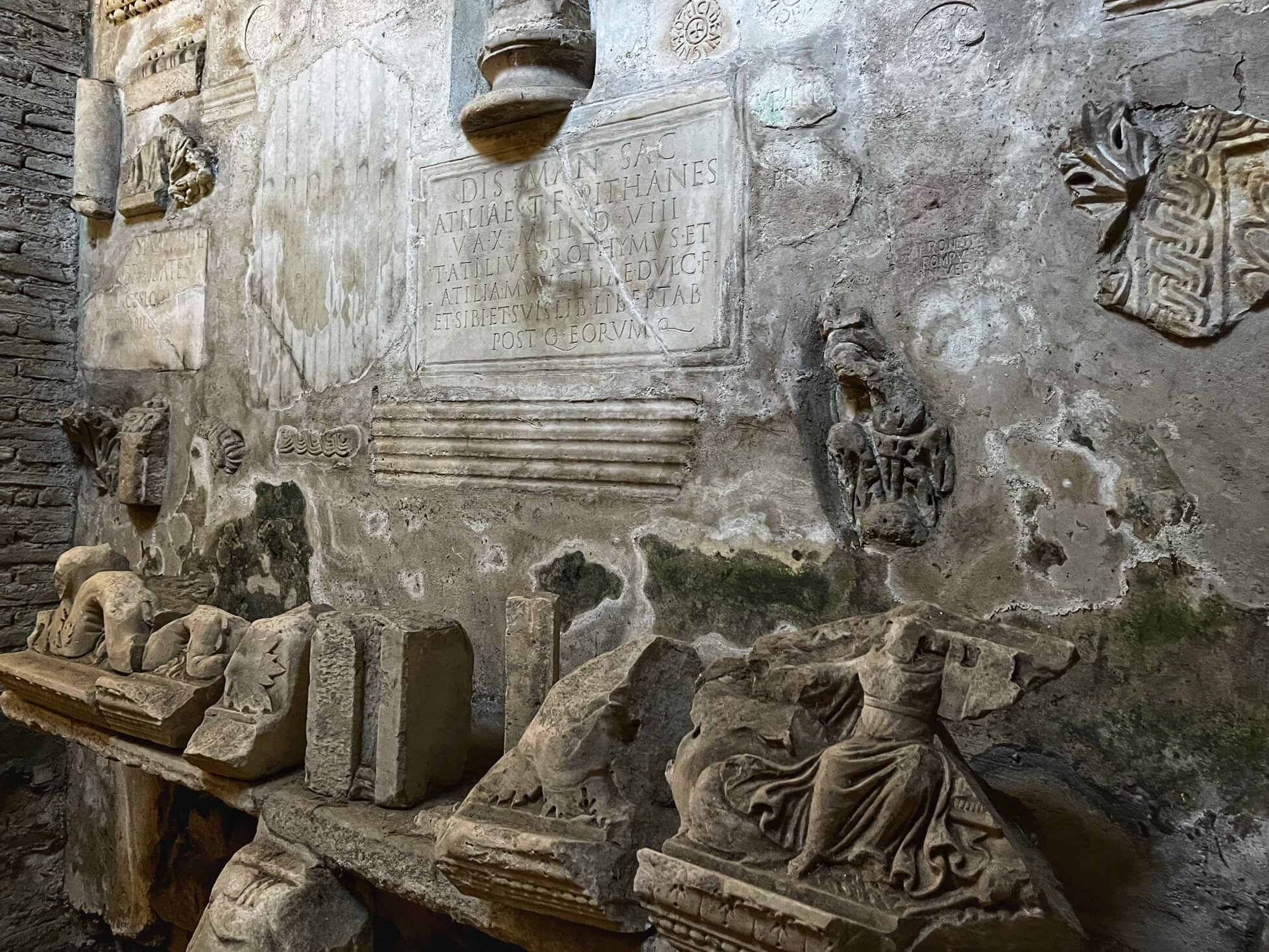
Recycling building material, especially if expensive like the marble, was very common during the Middle Ages. While walking in this church, don’t be surprised if you see marble slabs with writings and inscriptions: those were originally tombstones, which have been reused to pave the floor, you can still read the names of the people to whom they used to belong. Yes, you got it right: those tombstones have been literally stolen from their (dead) owners!
3. The schola cantorum

In the center of the Basilica we can see a special area, marked by a beautiful set of marble panels, forming a little fence: it’s the choir area, or schola cantorum. On the panels you can notice remarkable carvings, depicting fishes, anchors, doves or vine leaves: those are the most ancient Christian symbols, used by the very first Christians. They look so simple, yet each one of them carries an important meaning: the dove represents the Holy Spirit, the anchor is the symbol of Saint Clement and also recalls the shape of a cross, while the vine leaf refers to Jesus, who is the vine tree whose branches connect all the Christians.
The most interesting symbol is certainly the fish, but why? Because for the early Christians, the image of a fish concealed the profession of faith in God. How so? The letters composing the greek word for fish, Ichtys, form the initials of the sentence “Jesus Christ, Son of God, the Savior”. In times of persecutions, if you were Christian, you would draw a fish on the dirt to be recognized by your brethrens, but not by the authorities.
On some panels you will also notice some peculiar symbols, entirely made out of letters: these are the monograms of the famous Pope John II (533-535) who sponsored this amazing marble fence.
But this fence, although very beautiful, is not the reason why he is famous: did you know that John II is the first pope who changed his name when elected?
His birth name was in fact Mercurius, just like the pagan god: when he was elected pope, he had to change is name into a more appropriate one. Imagine what “Pope Mercurius” would have sounded like!
This little monogram is also particularly precious for the archaeologists: thanks to it, they were able to date the fence to the time of this pope. But how come that the fence (6th century AD) is more ancient than the church itself, which was built in the 1100s? That’s because the fence comes from the underground basilica from the 4th century AD, on top of which the Medieval Staint Clement was built.
4. The underground Basilica

When entering such an old building as Saint Clement’s Basilica, which is more than 900 years old, one would automatically think that this is the original building: wrong!
The building we see now above the ground is the “new” church, that has been built literally on top of the original 1700-years-old one!
This ancient church was discovered accidentally, as it’s often the case in Rome: how did it happen? This story is about “serendipity”, which is, as the dictionary puts it, “a fortunate and unexpected discovery completely made by accident”.
Everything starts with Saint Clement’s legendary biography, written in the 4th century. According to this legend, in times of persecution, Pope St. Clement used to celebrate the mass in his own house, and the Christians would join him in secret. According to the tradition, the Basilica was built right on top of his house: that’s what motivated the Irish dominican friar Joseph Mullooly, back in 1857, to start the excavations under the Medieval church in the attempt of finding Saint Clement’s legendary house.
Imagine his surprise when instead he found...another church!
It took awhile to empty it out from all the rubble and dirt, but when finally the building was completely excavated, Fr. Mullooly was finally able to explore the “old” Saint Clement’s Basilica, dating back to the 4th century AD. The church, which is even bigger than the one above, had to be abandoned because of the damages provoked by the Normans led by Robert the Guiscard, who sacked of Rome in 1084. The conditions of the church must have been so compromised, that Pope Paschal II, back in the 1100s, simply decided that it was not worthy to spend money on restoration works: it was best to bury it and reuse it as foundation for the “new” Saint Clement’s Basilica, that we can still visit nowadays.
5. The inscriptions in Italian vernacular
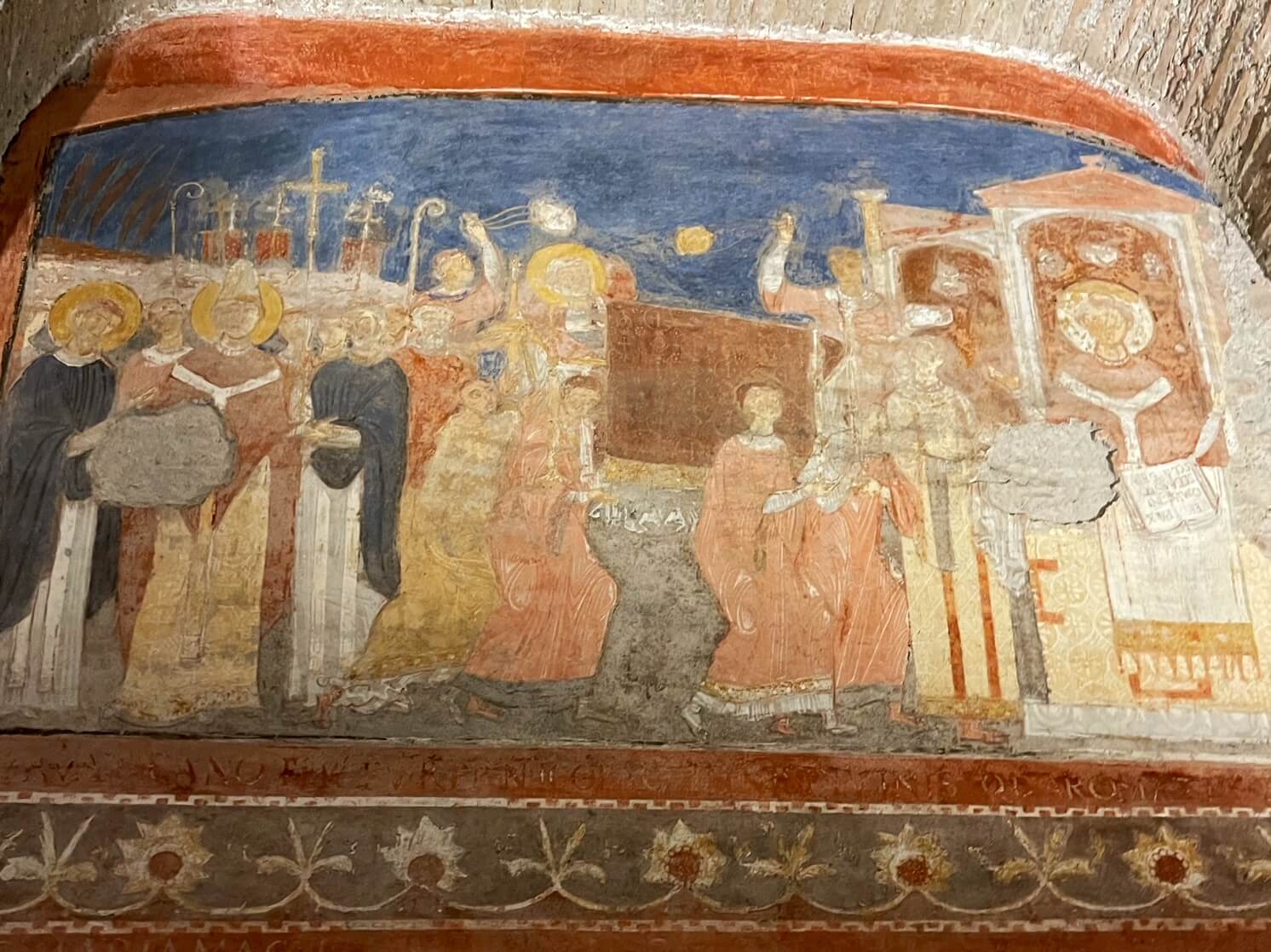
While exploring the underground basilica, you will notice many paintings, extraordinarily preserved. Some date back to the 6th century, others to the 9th, but most of them date back to the 11th century: these paintings were sponsored, as we learn from the inscriptions we find under each one of them, by a wealthy family of the time. Most of the frescoes depict stories from the legend of Saint Clement, focusing in particular on the miracles he performed.
In the most interesting painting we can see a famous episode of this legend. A roman patrician and his servant were trying to arrest Saint Clement because he was Christian, but a miracle saved him: suddenly the evil patricians and his slaves became so confused that they could not understand anymore what they were doing. Eventually, they ended up trying to tie up and arrest a column, while Saint Clement was able to escape. But what is so amazing about this painting?
If you look close to the heads of each character, you can read their dialogues, just like in comics! And here comes the most interesting part: those dialogues that we can still read are one of the very first examples of the Italian vernacular, which is basically a primitive form of modern Italian.
6. The temple of Mithras
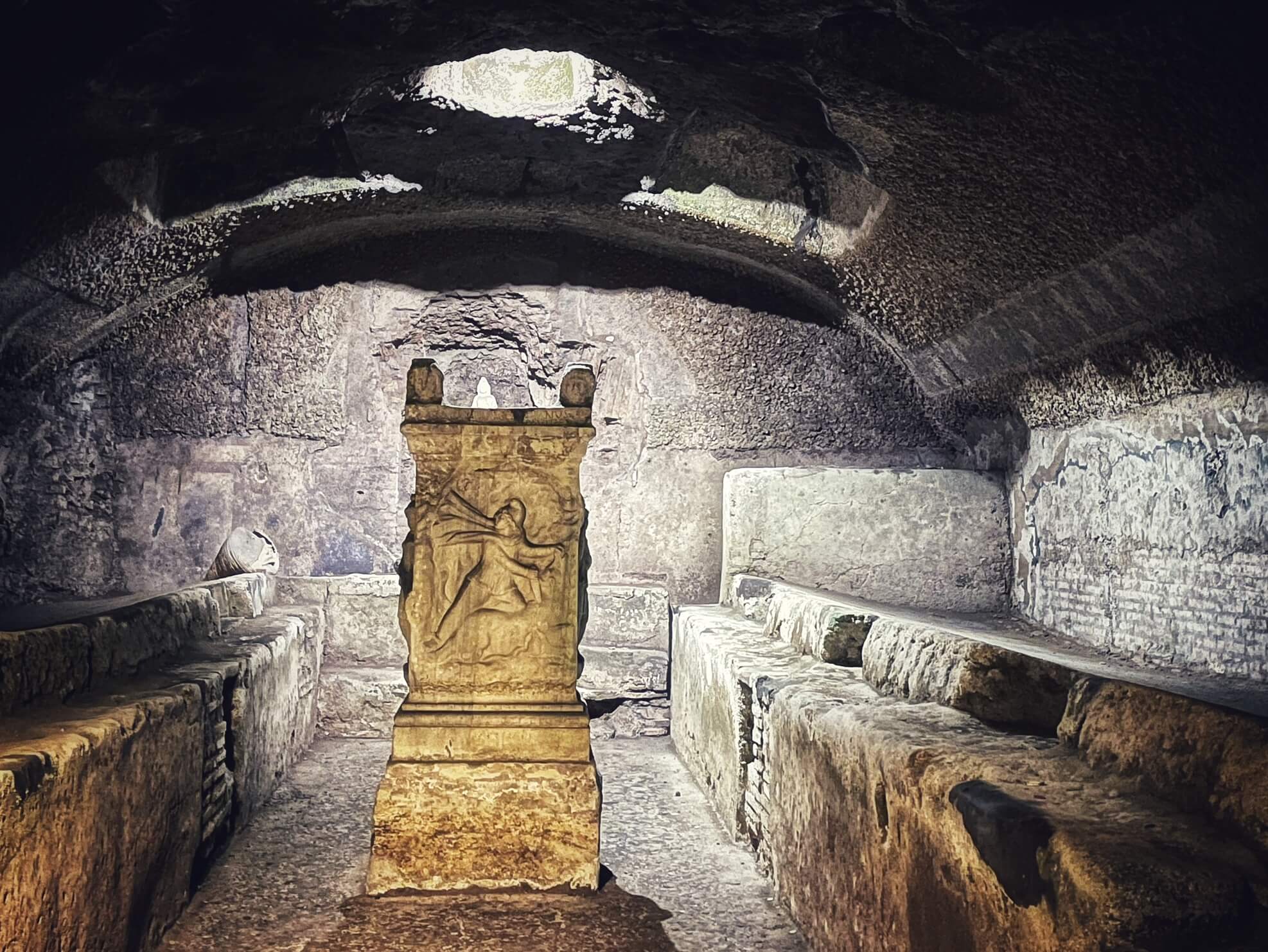
As the excavations kept going, also after the death of Fr. Mullooly, it became clear that the “old” Staint Clement’s Basilica was not the bottom of this excavation, not at all: the archaeologists kept digging, deeper and deeper, and they uncovered, to their great amazement, another level.
In this deeper level, which we can still visit, they found the ruins of two very ancient buildings: one was probably a house from the 2nd century AD, the other was apparently a mint, dating back to the 1st century AD.
Moreover, the first building had a big surprise in store for the archaeologists: in fact, they found a temple of Mithras, complete with altar, right in the middle of the house.
The temple, dating back to the 3rd century AD, was surrounded by other rooms, possibly used as schools or dining rooms, for ritual meals.
Mithras was a sun god from the East and his cult, reserved only to men, became pretty popular in Rome, in particular during the imperial age.
7. The underground river
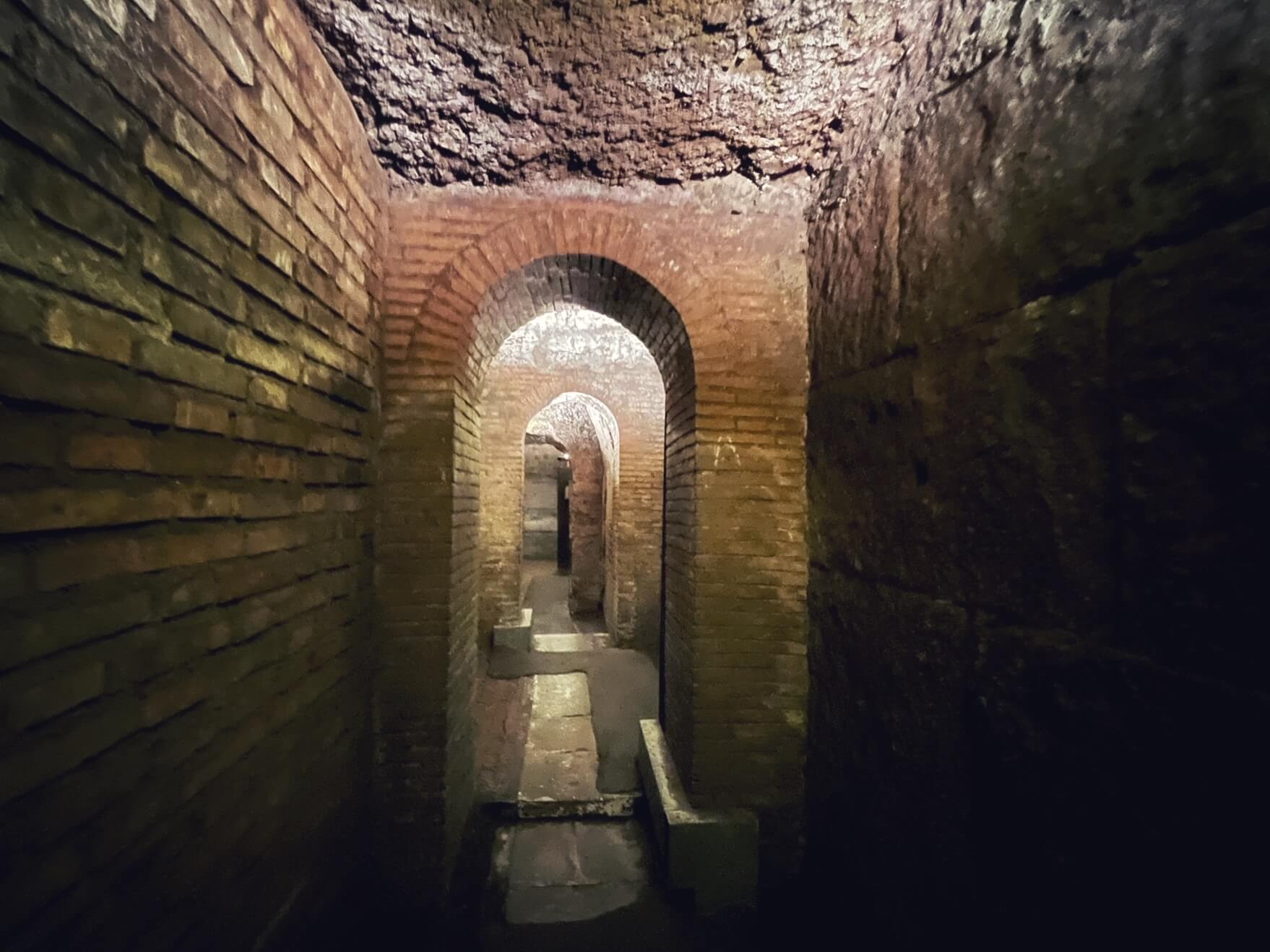
Did you know that at the very bottom level of Saint Clement’s underground, runs a river?
According to recent researches carried out by Rossella Rea, former director of the Colosseum, this river, which used to be much bigger in the past, originated from a spring located in the South of Rome, and was eventually channeled by the Romans into one of their many aqueducts, which is actually the same one that you can still see in the underground of the Colosseum.
Nowadays, it the visitors’ favorite place to throw coins, as it is supposed to bring good luck or grant a wish: do you want to try?
These are only a few of the wonders you can see at St. Clement’s Basilica: join us on our Underground Rome and Catacombs Tour to visit San Clemente and other fascinating subterranean sites in the Eternal City!
